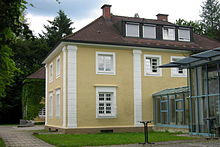Bernhard Borst

Bernhard Borst (born February 18, 1883 in Offenburg , Baden, † January 23, 1963 in Munich ) was a German architect , contractor and honorary senator .
life and work
Based in Munich since 1888, Borst started an apprenticeship as a bricklayer (1896–1898) at the age of 13 and then attended (1899–1903) the Munich building trade school . After completing his military service 1903–1905, he worked for various architects and gained recognition through his planning work. In 1908 he started his own business as an architect and building contractor. His construction company played a major role in August Exters' housing development in Pasing. In the "Pasinger Kolonie" he built his own house surrounded by a park-like garden. He planned and built numerous single-family houses in and around Munich. There are hardly any publications and no books by Bernhard Borst.
In 1913 he was honored at the International Building Exhibition in Leipzig. In 1925 Borst founded the trade journal Baukunst and acted as its editor until the journal was discontinued in 1931.
Bristle
He expressed his ideas of a better living and building culture in letters and implemented them in the construction of the Borstei residential complex , which became his life's work. In 1923 he bought a large piece of land on Dachauer Strasse for his construction company. As part of the building program of the city of Munich, he began building the first apartment blocks in the summer of 1924. When the city approved the construction of 26 houses in 1927, he decided to build apartments on the entire site with a floor plan loosened up by generous garden areas. The courtyards and houses were connected by vaults and passageways. This is how the Borstei was created with a central heating plant and all useful facilities as a settlement for the upper class. With garden concerts and other events for adults and children, he helped shape social life in the Borstei. Interested in art and nature, Borst gradually equipped the outdoor facilities with a wide variety of fountains, sculptures, reliefs and frescoes.
With the construction of the Borstei, the entrepreneur Borst realized one of his ideals:
“So I tried to solve the question of living: to combine the beauty of the single-family home with the practicality of an apartment. I wanted to coordinate everything with the housewife and the health of the people. "
And 13 years after the Borstei was built, he wrote in a letter:
“My ideal would be to build a city for 10-12,000 families. The houses average ground floor and two story, with large, very large gardens. Trees higher than the highest gable and flower gardens ... espalier trees on the south side, the espaliers up to the hanging plate [eaves], full of beautiful pears, apricots and peaches. Upper Bavarian flower gardens should bloom in all colors. "
From 1947 he lived with his wife Erna in Borstei, Hildebrandstrasse 9. He was a sponsor, client and friend of many artists. After the Second World War, he helped many with jobs out of their economic hardship. His grave is located in the Westfriedhof in Munich (grave no. 2-2-2).
Buildings (selection)

- 1901: Villa Rembrandtstrasse 7 in Munich
- from 1910: some villas in the villa colony Pasing I and II (e.g. Pippinger Straße 35 )
- 1911: Villa Rembrandtstrasse 13 in Munich
- Some terraced and semi-detached houses in Munich- Laim
- 1923: Villa Junkers in Gauting
- 1924–1929: Borstei housing estate in Munich (together with Oswald Bieber )
Awards
- 1933: Senator hc, Technical University of Karlsruhe
- 1953: Federal Cross of Merit
- 1953: Gold Medal of Honor of the City of Munich
- 1959: Bavarian Order of Merit
literature
- Axel Winterstein: Borstei. Bernhard Borst, living for an idea. Münchenverlag, Munich 2005, ISBN 3-934036-99-6 .
- Karl Stöger: The gardens of Borstei , Verlag Benedikt Bickel, Munich 2009, ISBN 978-3-922803-18-8
- Karl Stöger: The artworks of the Borstei , Verlag Benedikt Bickel, Munich 2010, ISBN 978-3-922803-19-5
Web links
Individual evidence
- ^ Karl Stöger: The gardens of the Borstei . Ed .: Line Borst. Verlag Benedikt Bickel for the Borstei Museum, Munich 2009, ISBN 978-3-922803-18-8 , p. 25 .
| personal data | |
|---|---|
| SURNAME | Borst, Bernhard |
| BRIEF DESCRIPTION | German architect, contractor and honorary senator |
| DATE OF BIRTH | February 18, 1883 |
| PLACE OF BIRTH | Offenburg , Baden |
| DATE OF DEATH | January 23, 1963 |
| Place of death | Munich |

